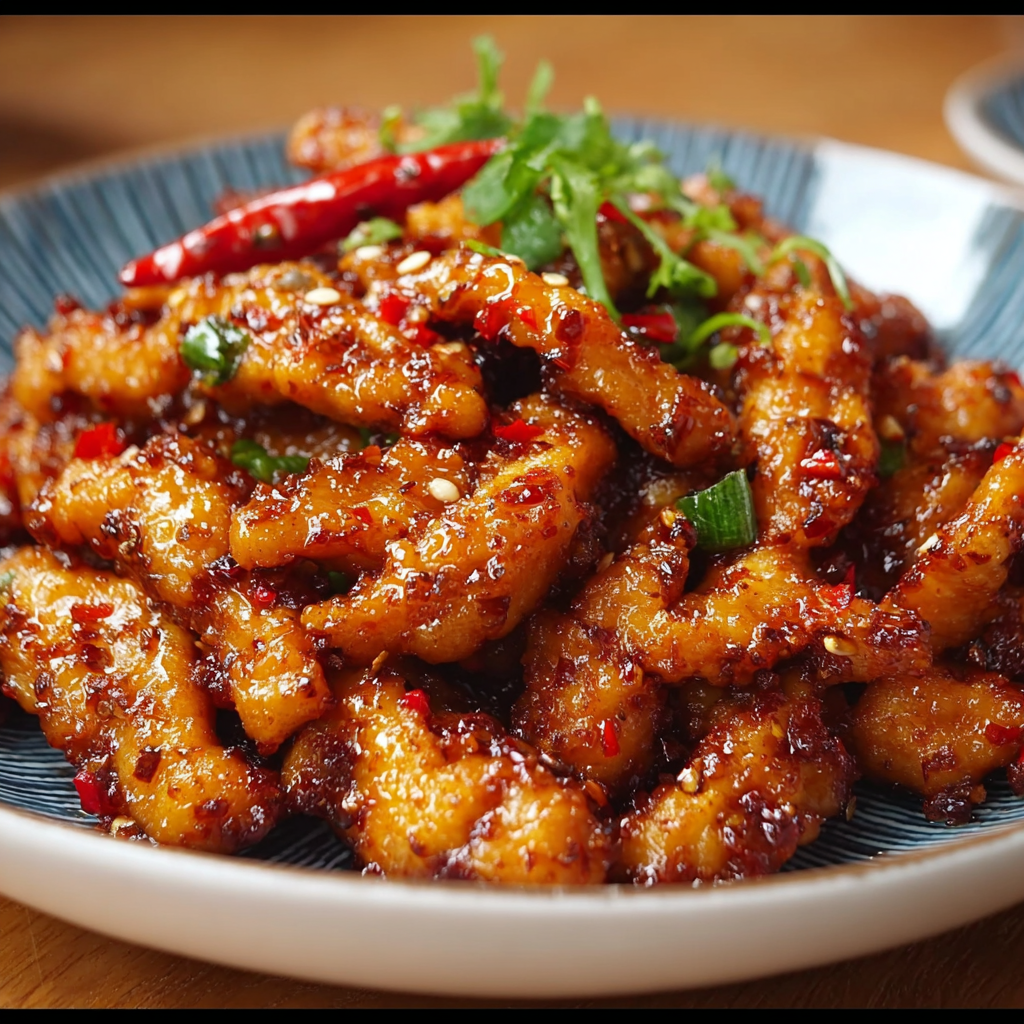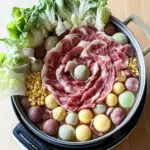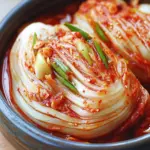Dragon Chicken is a bold and spicy Indo-Chinese favorite that brings restaurant-quality flavor right into your home kitchen. The tender chicken strips are marinated, coated, and fried to crispy perfection, then tossed in a sizzling sauce loaded with garlic, soy, chili, and a dash of sweetness to round out the flavor.
The combination of crunchy cashews, vibrant bell peppers, and aromatic ginger garlic paste makes each bite a flavorful explosion. Whether you serve it as a main dish or a standout appetizer, Dragon Chicken is sure to steal the spotlight on any dinner table.
Full Recipe
Ingredients:
For the Chicken Marinade:
-
250 grams boneless chicken breast, sliced into thin strips
-
1 teaspoon dark soy sauce
-
1 tablespoon chili garlic paste
-
1 egg
-
½ cup all-purpose flour
-
¼ cup cornstarch
-
1 tablespoon ginger garlic paste
-
Salt to taste
-
1 teaspoon black pepper
-
¼ teaspoon ajinomoto (optional)
For the Sauce:
-
2 tablespoons oil
-
3 dried red chilies
-
2 tablespoons cashews
-
1 large onion, thinly sliced
-
1 large capsicum (bell pepper), thinly sliced
-
1 tablespoon ginger garlic paste
-
1 tablespoon chili garlic paste
-
2 teaspoons dark soy sauce
-
¼ cup tomato ketchup
-
Salt to taste
-
¼ teaspoon ajinomoto (optional)
-
2 teaspoons sugar
-
Fresh coriander leaves, finely chopped (for garnish)
Directions:
-
In a bowl, combine chicken strips with all marinade ingredients. Mix well and let it marinate for 15 minutes.
-
Heat oil in a deep frying pan. Once hot, fry the marinated chicken until golden and crispy. Remove and set aside.
-
In another pan, heat oil and sauté dried red chilies and cashews until the cashews are golden.
-
Add sliced onions and capsicum. Sauté until slightly tender.
-
Stir in ginger garlic paste and chili garlic paste. Cook for a minute.
-
Add soy sauce, ketchup, salt, ajinomoto, and sugar. Stir and let it thicken slightly.
-
Add the fried chicken pieces and toss well to coat in the sauce.
-
Garnish with chopped coriander leaves and serve hot.
Prep Time: 15 minutes
Cooking Time: 20 minutes
Total Time: 35 minutes
Kcal: Approximately 350 kcal per serving
Servings: 4 servings
Origin and Popularity of Dragon Chicken
Dragon Chicken is a bold and spicy Indo-Chinese dish that has carved out a unique niche in the culinary world. Born from the fusion of Chinese cooking techniques with Indian flavor profiles, Dragon Chicken represents everything exciting about Indo-Chinese cuisine: heat, texture, and a symphony of bold sauces. Despite its name, there’s no mythical dragon involved—only the fierce punch of flavor that makes it memorable.
This dish is incredibly popular in Indian restaurants and food stalls that serve Indo-Chinese fare. It’s often ordered as an appetizer but can easily be enjoyed as a main course with fried rice or noodles. Over the years, Dragon Chicken has become a go-to for those who crave spicy, saucy dishes with a deep-fried crunch and vibrant garnish.
Flavor Profile and Texture
Dragon Chicken is known for its distinctive, layered flavor and rich texture. The chicken is first marinated in a spicy batter and deep-fried until it forms a crispy golden crust. This gives it a satisfying crunch with every bite. The sauce it is tossed in is a medley of heat, tang, and umami—featuring garlic, chili paste, soy sauce, and ketchup. The sweetness from the ketchup balances the intense heat from the chili paste, while the soy sauce adds depth and savory undertones.
The addition of sautéed onions, bell peppers, dried red chilies, and crunchy cashews takes the flavor and texture to another level. It’s a dish that plays on contrasts—crispy and saucy, spicy and sweet, tender and crunchy—all at once. This complexity is what keeps Dragon Chicken exciting and satisfying from the first to the last bite.
Cultural Relevance in Indo-Chinese Cuisine
Indo-Chinese cuisine is a culinary bridge between the robust flavors of Indian spices and the subtle, umami-rich notes of Chinese cooking. Dragon Chicken epitomizes this blend beautifully. It’s not authentically Chinese and certainly not traditional Indian, but rather a brilliant hybrid born out of culinary experimentation and adaptation.
In India, Indo-Chinese dishes are immensely popular, especially in urban and semi-urban areas. From street stalls to fine dining establishments, the menu is incomplete without classic options like Hakka noodles, Manchurian, and of course, Dragon Chicken. The popularity of such dishes is rooted in their adaptability—chefs can easily customize the spice levels or tweak the sauce according to local tastes.
Serving Suggestions and Pairings
Dragon Chicken is incredibly versatile when it comes to how it can be served. As an appetizer, it shines on its own with perhaps a small side of chili vinegar or a dipping sauce. When served as a main course, it pairs wonderfully with simple accompaniments that allow its bold flavor to stand out.
Some of the best pairings include:
-
Egg fried rice or vegetable fried rice
-
Garlic noodles or plain Hakka noodles
-
Steamed jasmine rice for a lighter option
-
A crisp green salad with sesame dressing to balance the heat
The sauce from Dragon Chicken also lends itself well to mopping up with Indian flatbreads like naan or paratha, though that’s less traditional.
Customizations and Variations
One of the best things about Dragon Chicken is how customizable it is. If you’re cooking at home, you can easily adjust the recipe to match your heat tolerance or dietary preferences.
-
For a milder version: Reduce the amount of chili garlic paste and omit dried red chilies.
-
For extra crunch: Add toasted sesame seeds or double-fry the chicken pieces.
-
Vegetarian option: Replace chicken with cauliflower (Gobi), tofu, or paneer. These absorb the sauce beautifully and work well with the same flavor profile.
-
Healthier version: Instead of deep-frying, air fry or pan-fry the chicken with minimal oil. The texture won’t be exactly the same, but the flavor will still shine through.
-
Kids’ version: Omit the spicier elements and add a touch more ketchup to sweeten the sauce.
This adaptability makes Dragon Chicken a great option for family dinners or parties with varied palates.
Presentation and Garnishing Tips
Visual appeal plays a big role in how Dragon Chicken is received. The dish is vibrant—bright reds and greens from the sauce and vegetables make it look as appetizing as it tastes. For an impressive presentation, serve it on a dark plate to make the colors pop. Garnish with finely chopped spring onions, fresh coriander, and a sprinkle of sesame seeds or cashews for a gourmet finish.
To elevate the dish further, consider plating it over a bed of shredded lettuce or cabbage. This not only looks beautiful but also adds a fresh, cooling contrast to the heat of the chicken.
Why It’s a Crowd Favorite
What makes Dragon Chicken such a hit? It’s that perfect balance of flavors and textures—crispy yet juicy, spicy yet sweet, bold yet comforting. It satisfies cravings for takeout-style food while being easy enough to prepare at home. Whether served at casual family dinners, as a party appetizer, or even as part of a festive spread, it never fails to draw compliments.
Its dramatic name also adds to the allure. Saying you’re serving “Dragon Chicken” instantly gets attention and sparks curiosity, especially among guests unfamiliar with Indo-Chinese cuisine.
Nutritional Perspective
Dragon Chicken is undoubtedly a treat, often considered indulgent due to its frying process and rich sauce. That said, it can be adapted to be lighter. Choosing lean chicken breast, reducing the amount of oil, and using air-frying techniques can make it more health-friendly. You can also balance out your meal by pairing it with vegetables, brown rice, or whole-grain noodles.
The protein from the chicken, the antioxidants from bell peppers and onions, and the healthy fats from cashews offer some nutritional value, making it more than just a “cheat day” dish if modified wisely.
Cooking Tips for Best Results
-
Marinate the chicken for at least 15–20 minutes to allow the flavors to penetrate.
-
Don’t overcrowd the frying pan; fry in batches for even crispiness.
-
Use fresh ingredients, especially garlic and ginger, to enhance aroma and flavor.
-
Balance the sauce: Always taste before adding salt, as soy sauce and ketchup already contain sodium.
-
If you’re making a large batch, fry the chicken and prepare the sauce separately. Combine just before serving to retain the crispiness.
Conclusion
Dragon Chicken is more than just another spicy chicken dish—it’s a culinary experience. With its roots in Indo-Chinese fusion, it brings together bold spices, crispy textures, and a lip-smacking sauce that keeps you coming back for more. Its ability to be customized, served in various ways, and adapted to different diets makes it a staple worth mastering in your kitchen.
Whether you’re an adventurous cook or just someone who loves vibrant, flavorful meals, Dragon Chicken is a must-try dish that promises both satisfaction and a little bit of spice-driven excitement on your plate.






